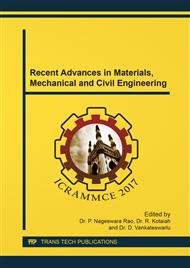[1]
G. K. Klute, J. Czerniecki, and B. Hannaford, 'Development of powered prosthetic lower limb,', in Proc. 1st Nat. Meeting, Veterans Affairs Rehabilitation R&D Service, Washington, DC, Oct. (1998).
Google Scholar
[2]
H. Herr, D. Paluska, P. Dilworth, and S. Kwau, 'A hybrid actuator comprising motor, spring and variable-damper elements,', Patent Provisional F-51 SN 60/666,876, Mar. 31, (2005).
Google Scholar
[3]
S. K. Au, J. Weber, and H. Herr, 'Biomechanical design of a powered ankle-foot prosthesis,', in Proc. IEEE Int. Conf. Rehabilitation Robotics, Noordwijk, The Netherlands, June (2007).
DOI: 10.1109/icorr.2007.4428441
Google Scholar
[4]
S. Au, M. Berniker, and H. Herr, Powered ankle-foot prosthesis to assist level-ground and stair-descent gaits,, Neural Networks, vol. 21, no. 4, May 2008, p.654–666.
DOI: 10.1016/j.neunet.2008.03.006
Google Scholar
[5]
Gregory S Sawicki and Daniel P Ferris 'A pneumatically powered knee-ankle-foot orthosis (KAFO) with myoelectric activation and inhibition,, Journal of Neuro Engineering and Rehabilitation (2009).
DOI: 10.1186/1743-0003-6-23
Google Scholar
[6]
M Todd Farrell and Hugh Herr A method to determine the optimal features for control of a powered lower-limb prostheses,, 33rd Annual International Conference of the IEEE EMBS Boston, Massachusetts USA, August 30 - September 3, (2011).
DOI: 10.1109/iembs.2011.6091493
Google Scholar
[7]
Alena M.Grabowski and Susan D'Andrea,'Effects of a powered ankle-foot prosthesis on kinetic loading of the unaffected leg during level ground walking,', Journal of Neuro Engineering and Rehabilitation (2013).
DOI: 10.1186/1743-0003-10-49
Google Scholar
[8]
David Hill & Hugh Herr, Effects of a powered ankle-foot prosthesis on kinetic loading of the contralateral limb,, Media Lab Massachusetts Institute of Technology Cambridge, Massachusetts, USA, (2013).
DOI: 10.1109/icorr.2013.6650375
Google Scholar
[9]
Carl D.Hoover, George D.Fulk, and Kevin B. Fite,Stair Ascent with a Powered Transfemoral Prosthesis Under Direct Myoelectric Control,, IEEE/ASME Transactions on Mechatronics VOL. 18, NO. 3, JUNE (2014).
DOI: 10.1109/tmech.2012.2200498
Google Scholar
[10]
Shultz AH, Lawson BE, Goldfarb M, Variable Cadence Walking and Ground Adaptive Standing With a Powered Ankle Prosthesis,, IEEE Transneural System Rehabilitation Engineering, Apr (2016).
DOI: 10.1109/tnsre.2015.2428196
Google Scholar
[11]
Jeremy D Brown, Timothy S Kunz and Duane Gardner, An emperical Evaluation of Force Feedback in Body Powered Prostheses,, IEEE Transactions on Neural Systems and Rehabilitation Engineering Volume: 25, Issue: 3, March (2017).
DOI: 10.1109/tnsre.2016.2554061
Google Scholar
[12]
Elissa D. Ledoux and Michael Goldfarb, Control and Evaluation of a Powered Transfemoral Prosthesis for Stair Ascent,, IEEE Transactions on Neural Systems and Rehabilitation Engineering ( Volume: PP, Issue: 99 ) January (2017).
DOI: 10.1109/tnsre.2017.2656467
Google Scholar
[13]
Anne E. Martin and Robert D. Gregg, Stable, Robust Hybrid Zero Dynamics Control of Powered Lower-Limb Prostheses,, IEEE Transactions on Automatic Control (Volume: PP, Issue: 99) January (2017).
DOI: 10.1109/tac.2017.2648040
Google Scholar
[14]
E. D.Ledoux, B. E. Lawson, A. H. Shultz, H. L. Bartlett, and M. Goldfarb, Metabolics of Stair Ascent with a Powered Transfemoral Prosthesis,, presented at the IEEE/EMBS Eng. Medicine Biology Conf., (2015).
DOI: 10.1109/embc.2015.7319589
Google Scholar
[15]
K. A.Ingraham, N. P. Fey, A. M. Simon, and L. J. Hargrove, Assessing the Relative Contributions of Active Ankle and Knee Assistance to the Walking Mechanics of Transfemoral Amputees Using a Powered Prosthesis,, PloS One, vol. 11, p. e0147661, (2016).
DOI: 10.1371/journal.pone.0147661
Google Scholar
[16]
A. H. Shultz, B. E. Lawson, and M. Goldfarb, Running with a powered knee and ankle prosthesis,, IEEE Trans. Neural Syst. Rehabil. Eng., vol. 23, (2014).
DOI: 10.1109/tnsre.2014.2336597
Google Scholar
[17]
D.Datta, B.Heller, and J.Howitt, A comparative evaluation of oxygen consumption and gait pattern in amputees using Intelligent Prostheses and conventionally damped knee swing-phase control,, Clinical Rehabil., vol. 19, pp.398-403, (2005).
DOI: 10.1191/0269215505cr805oa
Google Scholar


